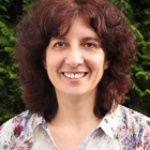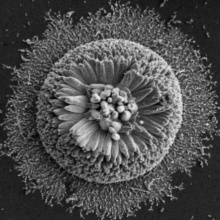In our research, we use anisotropic biotemplates like DNA, wildtype tobacco mosaic virus (TMV) as well as several TMV mutants. They exhibit advantageous interparticle interactions different from conventional spheres and are attractive for assembly of new organic-inorganic hybrid nanostructures with well-defined dimensions and unique material properties. We structure the templates via different assembly techniques like molecular combing, convective assembly, controlled evaporation and stamping. Upon mineralization, the template surface is selectively covered with a thin inorganic layer (e.g. ZnO and ZnS). The synthesis of the corresponding organic-inorganic structures is carried out using a chemical bath deposition (CBD) method at close to ambient conditions. To achieve control over the mineralization behavior (to induce or suppress the mineralization), we study the interactions on the organic-inorganic interface with the aim to understand the growth mechanism (induced mineralization) or manipulate the surface hydrophilicity of the template (TMV) through covalent coupling of polymer molecules (suppressed mineralization). Furthermore, the virus-directed approach for selective in-situ mineralization of nanosized ZnO is used in the fabrication of a functional device. The deposition of TMV/ZnO composite on substrates with pre-structured electrodes results in formation of Field Effect Transistors (FETs). FETs synthesized using this method do not require any post-synthesis treatment and can be operationalized as such.
In cooperation with Dr. Sabine Eiben and Prof. Dr. (apl.) Christina Wege, Institute for Biomaterials and Biomolecular Systems, University of Stuttgart, Dr. Rudolf Hoffmann and Prof. Jörg J. Schneider, Eduard Zintl Institute for Inorganic and Physical Chemistry, Technical University of Darmstadt, Dr. Vladimir Atanasov, Institute of Chemical Process Engineering, University of Stuttgart and Prof. Dr. Andreas Fery, Leibniz Institute of Polymer Research, Dresden.
- Atanasova, P.; Rothenstein, D.; Schneider, J. J.; Hoffmann, R. C.; Dilfer, S.; Eiben, S.; Wege, C.; Jeske, H.; Bill, J., “Virus-Templated Synthesis of ZnO Nanostructures and Formation of Field-Effect Transistors” Advanced Materials 2011, 23, 4918.
- Atanasova, P.; Stitz, N.; Sanctis, S., Maurer, J. H. M.; Hoffmann, R. C.; Eiben, S.; Jeske, H.; Schneider, J. J. and Bill, J. “Genetically improved monolayer-forming tobacco mosaic viruses to generate nanostructured semiconducting bio/inorganic hybrids” Langmuir 2015, 31, 3897.
- Stitz, N.; Eiben, S.; Atanasova, P.; Domingo, N.; Leineweber, A.; Burghard, Z. and Bill, J. „Piezoelectric Templates - New Views on Biomineralization and Biomimetics” Sci Rep-Uk. 2016, 6.
- Atanasova, P., Kim, I., Chen, B., Eiben, S., Bill, J. “Controllable Virus-Directed Synthesis of Nanostructured Hybrids Induced by Organic/Inorganic Interactions” Adv Biosys. 2017, 1700106.
- Atanasova, P. “Semiconducting hybrid layer fabrication scaffolded by virus shells” Virus-Derived Nanoparticles for Advanced Technologies 2018, (Wege, C. and Lomonossoff, G. P. (eds.)). Heidelberg, London, New York: Humana Press, Springer Science+Business Media.
- Atanasova, P.; Atanasov, V.; Wittum, L.; Southan, A.; Choi, E.; Wege, C.; Kerres, J.; Eiben, S. and Bill, J. “Hydrophobization of tobacco mosaic virus to control the mineralization of organic templates” Nanomaterials 2019, 9, 800.
Inorganic and organic-inorganic porous materials with tunable pore size as catalyst supports
The goal of this project is to establish a template-based process for the formation of structured mesoporous organic-inorganic (hybrid) or wholly inorganic materials with tunable pore diameters. These materials will be subsequently used as supports for the site-specific attachment of catalyst molecules to study the manifestations of molecular heterogeneous catalysis in confined or localized geometries.
This project is a part of the Collaborative Research Center 1333 “Molecular Heterogeneous Catalysis in Confined Geometries”, University of Stuttgart
Oxide inverse opals
Semiconductor oxides with a hierarchical inverse opal structure have high surface area as well as open and ordered porosity in multiple length scales. Owing to these reasons, these materials have found application in catalysis. This involves nascent catalysis (where the semiconductor oxide acts as a catalyst in isolation) or supported catalysis (where the opaline structure allows for the selective immobilization of metal nanoparticles or complex catalysts).
In cooperation with Prof. Thomas Sottmann, Institute of Physical Chemistry, University of Stuttgart
Organic-inorganic foams
Nanofoams based on polymethylmethacrylate (PMMA) and polystyrene (PS) are another class of porous materials. They can be used as a template for the synthesis of porous organic-inorganic hybrids, which find application in catalysis, sorption and sensing.
In cooperation with Prof. Thomas Sottmann, Institute of Physical Chemistry, University of Stuttgart
- Qawasmi, Y.; Atanasova, P.; Jahnke, T.; Burghard, Z.; Müller, A.; Grassberger, L.; Strey, R.; Bill, J. and Sottmann, T. “Synthesis of Nanoporous Organic/Inorganic Hybrid Materials with Adjustable Pore Size” Colloid and Polymer Science 2018, 296, 1805.

Petia Atanasova
Dr.Groupleader







